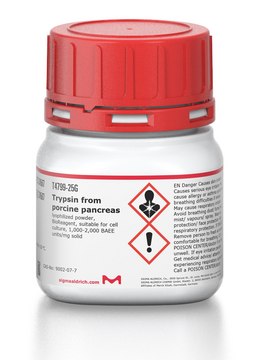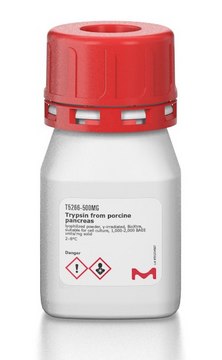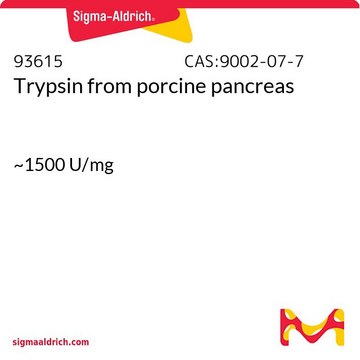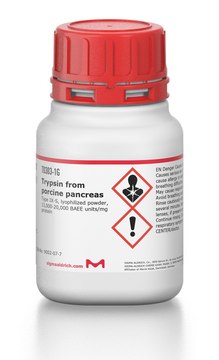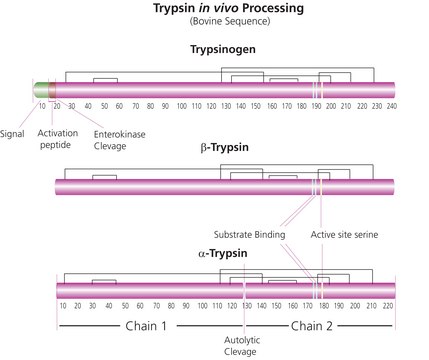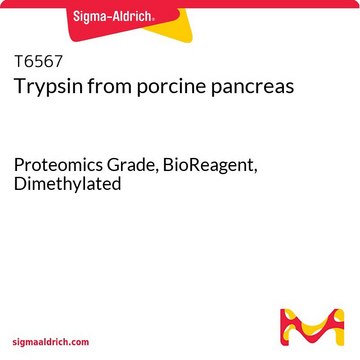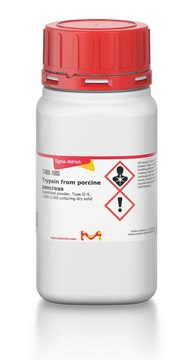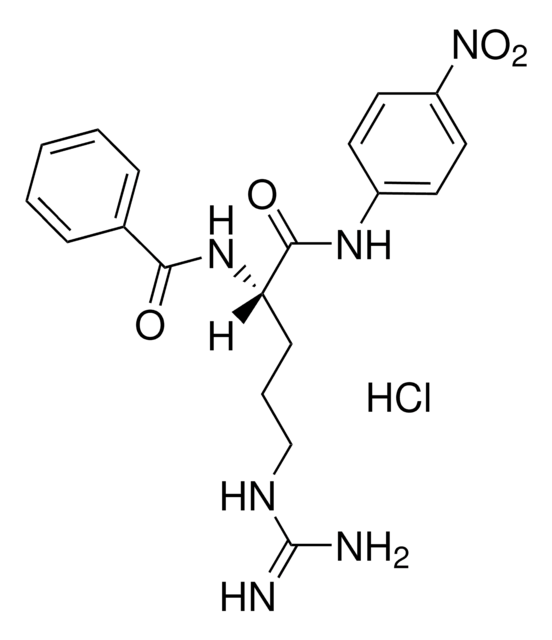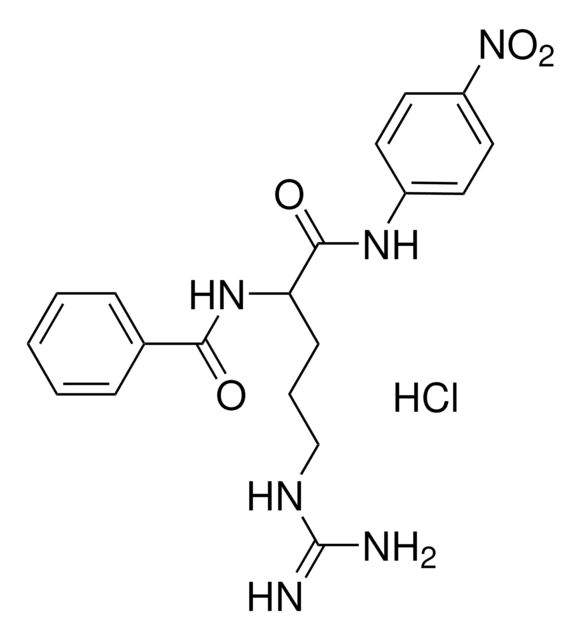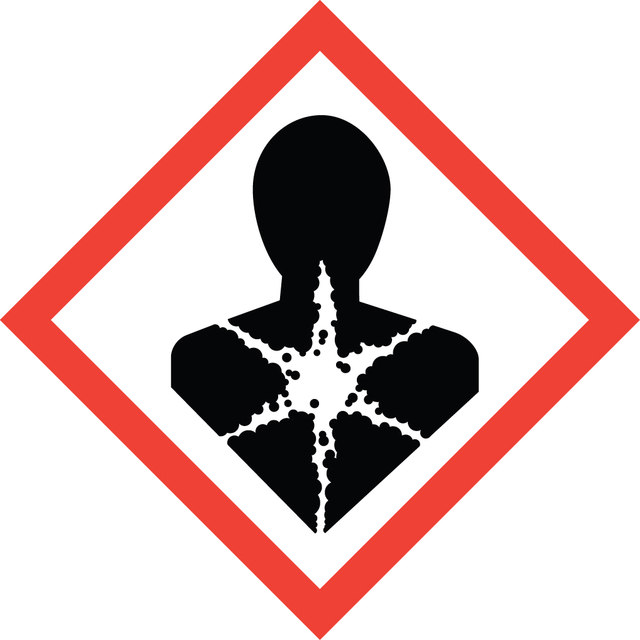Recommended Products
Looking for similar products? Visit Product Comparison Guide
Application
For trypsin digestion of peptides, use a ratio of about 1:100 to 1:20 for trypsin:peptide. The typical use for this product is in removing adherent cells from a culture surface. The concentration of trypsin necessary to dislodge cells from their substrate is dependent primarily on the cell type and the age of the culture. Trypsins have also been used for the re-suspension of cells during cell culture, in proteomics research for digestion of proteins and in various in-gel digestionsns†. Additional applications include assessing crystallization by membrane-based techniques and in a study to determine that protein folding rates and yields can be limited by the presence of kinetic traps.
Biochem/physiol Actions
Trypsin cleaves peptides on the C-terminal side of lysine and arginine residues. The rate of hydrolysis of this reaction is slowed if an acidic residue is on either side of the cleavage site and hydrolysis is stopped if a proline residue is on the carboxyl side of the cleavage site. The optimal pH for trypsin activity is 7-9. Trypsin can also act to cleave ester and amide linkages of synthetic derivatives of amino acids. EDTA is added to trypsin solutions as a chelating agent that neutralizes calcium and magnesium ions that obscure the peptide bonds on which trypsin acts. Removing these ions increases the enzymatic activity.
Serine protease inhibitors, including DFP, TLCK, APMSF, AEBSEF, and aprotinin, amongst others, will inhibit Trypsin.
Serine protease inhibitors, including DFP, TLCK, APMSF, AEBSEF, and aprotinin, amongst others, will inhibit Trypsin.
Unit Definition
1 U corresponds to the amount of enzyme which increases the absorbance at 253 nm by 0.001 per minute at pH 7.6 and 25°C (N-benzoyl-L-arginine ethyl ester, Cat. No. 12880, as substrate)
One BAEE unit will produce a ΔA253 of 0.001 per min at pH 7.6 at 25° C using BAEE as substrate. One BTEE unit = 320 ATEE units. Reaction volume = 3.2 mL (1 cm light path).
Other Notes
Enzymatic hydrolysis of rapeseed proteins
Sales restrictions may apply
Signal Word
Danger
Hazard Statements
Precautionary Statements
Hazard Classifications
Eye Irrit. 2 - Resp. Sens. 1 - Skin Irrit. 2 - STOT SE 3
Target Organs
Respiratory system
Storage Class Code
11 - Combustible Solids
WGK
WGK 1
Personal Protective Equipment
dust mask type N95 (US), Eyeshields, Gloves
Regulatory Information
新产品
Choose from one of the most recent versions:
Already Own This Product?
Find documentation for the products that you have recently purchased in the Document Library.
M. Lacroix et al.
Can. Inst. Food Sci Technol. J., 16, 242-242 (1983)
Anamaria Ioana Paştiu et al.
Parasites & vectors, 12(1), 586-586 (2019-12-18)
Foodborne toxoplasmosis in humans can be due to the exposure to tissue cysts of Toxoplasma gondii through the consumption of meat, including pork, of infected animals. Traditional Romanian food habits include pork as the preferred meat, while backyard pig rearing
Masaya Tsunehiro et al.
Journal of chromatography. B, Analytical technologies in the biomedical and life sciences, 925, 86-94 (2013-03-26)
A simple and efficient method based on magnetic-bead technology has been developed for the separation of phosphorylated and nonphosphorylated low-molecular-weight biomolecules, such as nucleotides, phosphorylated amino acids, or phosphopeptides. The phosphate-binding site on the bead is an alkoxide-bridged dinuclear zinc(II)
Mian Zhou et al.
Nature, 495(7439), 111-115 (2013-02-19)
Codon-usage bias has been observed in almost all genomes and is thought to result from selection for efficient and accurate translation of highly expressed genes. Codon usage is also implicated in the control of transcription, splicing and RNA structure. Many
Paul P Geurink et al.
Journal of medicinal chemistry, 56(3), 1262-1275 (2013-01-17)
Proteasomes degrade the majority of proteins in mammalian cells by a concerted action of three distinct pairs of active sites. The chymotrypsin-like sites are targets of antimyeloma agents bortezomib and carfilzomib. Inhibitors of the trypsin-like site sensitize multiple myeloma cells
Our team of scientists has experience in all areas of research including Life Science, Material Science, Chemical Synthesis, Chromatography, Analytical and many others.
Contact Technical Service